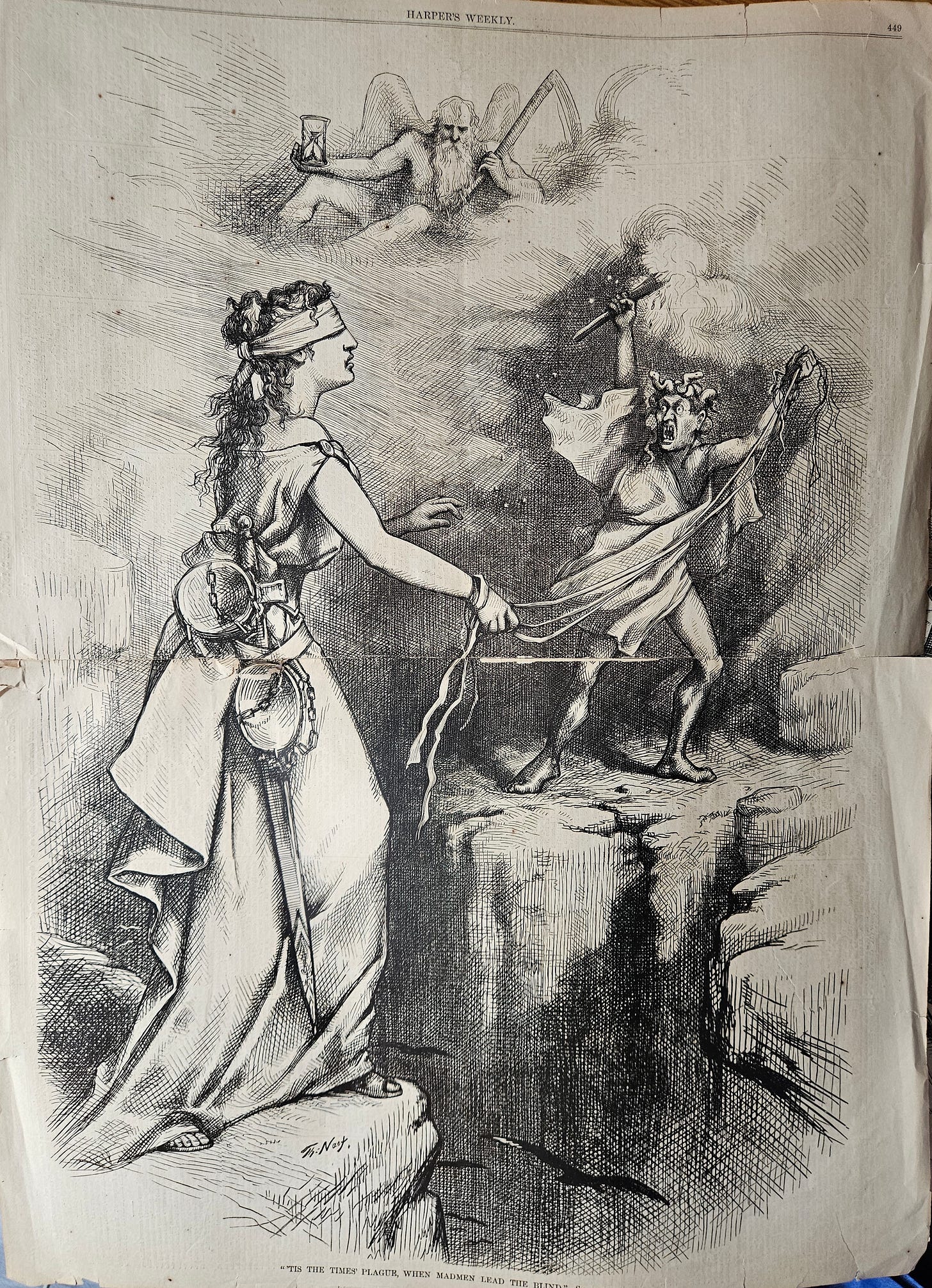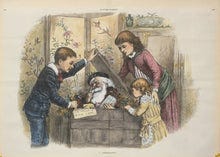"'Tis The Times' Plague, When Madmen Lead the Blind" (drawing by Thomas Nast-in Harper's Weekly, June 3, 1876--"The Centennial Collection")
One of 40+ 'Nasts' I'll be posting/Things haven't changed much in almost 150 years!
Justice is getting led astray! (And given the man above with the hourglass, time is running out!).
I found this full page print and almost 50 other late-1800s original "Nast" drawings from Harper’s Weekly Magazine in a Seattle bookstore, in a pile sitting on a cart. I pulled all the incredible, mostly-political prints out (many images Nast created in 1870s were confronting the Tammany Hall as you’ll see) and asked “How much” from a passing clerk. When he said “$4 each” I bought them all, burning my credit card. Fortunately, I discovered later they’re worth a bit more, so I wasn’t so crazy after all in acquiring such great artworks.
Always imagined I’d have them presented in an art show of some kind. So here they are!
Here’s some info about Thomas Nast (from Philadelphia Print Shop):
Harper's Weekly, a newspaper in the last half of the nineteenth and early twentieth century, presented a mixture of news stories, gossip, poetry, and most notably, wood-engraved illustrations. Amongst the most famous of the illustrators who worked for the magazine was Thomas Nast, "father" of American political cartoonists. During the second half of the nineteenth century, Nast became the most significant illustrator of American political and social issues, and his pointed images exerted a great impact on public opinion. More than a mere cartoonist, Nast was an innovator of icons, popularizing or instituting many now familiar subjects such as the Republican elephant, the Democratic donkey, John Bull, Uncle Sam, and Columbia.
More on the history of Harper's Weekly and Nast:
Harper’s Weekly, A Journal of Civilization began publication in 1857 as a venture of the New York publishing firm of Harper and Brothers. The Weekly was among a group of new magazines that benefited from lower postal rates and provisions that publishers instead of subscribers paid the postage. It was soon popular thanks to its use of illustrations, the relatively high quality of its printing, and its editorial content. By the end of 1861, the magazine had a circulation of 120,000 and stood, in terms of readership, among the leading magazines of the Civil War period.
Most magazines suffered circulation losses when the southern states seceded. The popularity of Harper’s Weekly, however, grew because of its coverage of the Civil War. It was widely read by the soldiers of the Union Army, and the magazine hired artists, including Thomas Nast, to follow the army in its campaign.
Although editorially the magazine supported the Lincoln administration and the Union cause, it was less strident in tone than Nast’s work “Compromise with the South,” described by many as Nast’s first great political cartoon, was published in the September 3, 1864 issue. The Republicans distributed reprints of this cartoon widely in campaigning for Lincoln’s reelection.
In 1863 George William Curtis became editor of Harper’s Weekly and under him the magazine’s influence grew. Curtis and Nast worked well together for a time. During the 1870s Nast’s cartoons attacking William Tweed and his political cronies in New York City gained national attention, and boosted the magazine’s circulation. It especially received favorable notice from Republicans. Both Curtis and Nast, although they had their disagreements, were important Republicans, although the magazine was ostensibly non-partisan. The magazine’s influence was greatest during the 1870s.
Harper’s Weekly began to lose favor in 1884 as a result of Curtis’ and Nast’s opposition to the Republican presidential nominee, James G. Blaine. Curtis and the magazine’s publisher consciously spoke out against Blaine knowing that it would cost circulation. What they did not count on was the widespread and vitriolic attacks on the magazine, especially those directed towards Nast, leveled by Republican publications Harper’s Weekly never recovered fully from this episode. Nast left the magazine in 1887 as the result of on-going conflicts with its editor and publisher Harper’s Weekly ceased publishing in 1916.
For additional information see Frank Luther Mott, A History of American Magazines, Vol. II, 1850-1865 (Cambridge, MA: Harvard University Press, 1938): 469-87.
———-







What a find! But hardly the only Find you've had! Our son, Joe, has the same inclination when it comes to bookstores with old treasures.